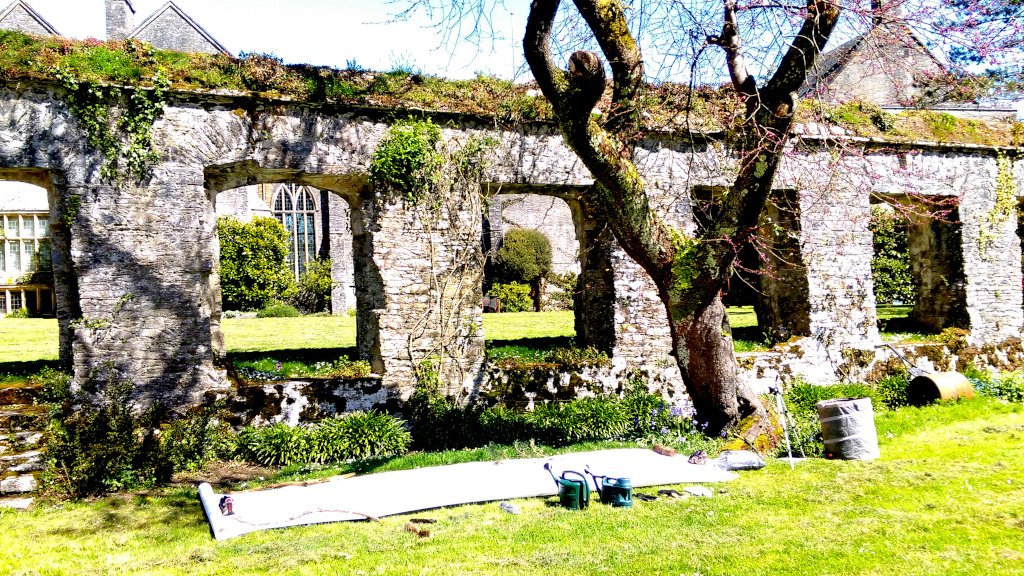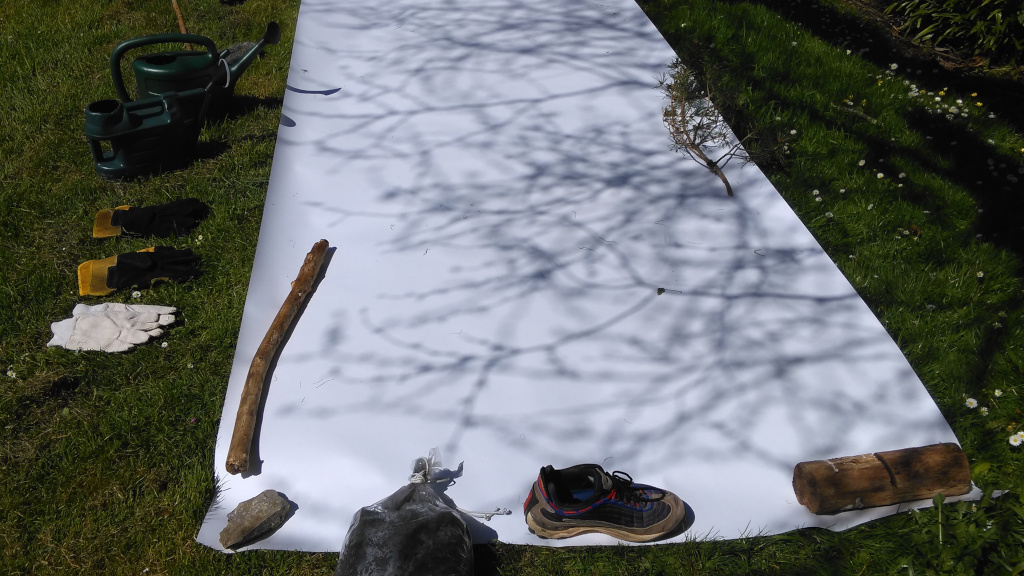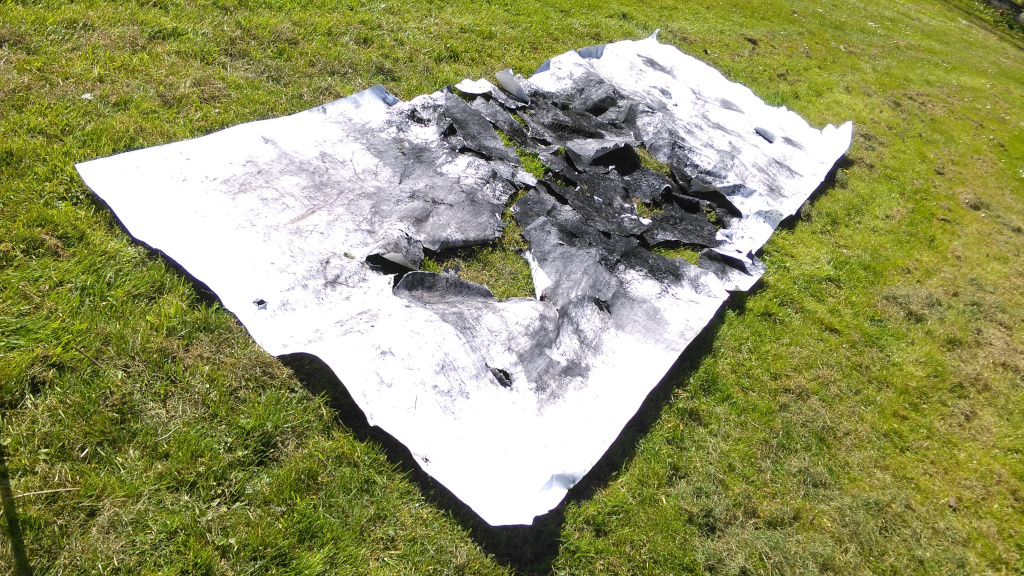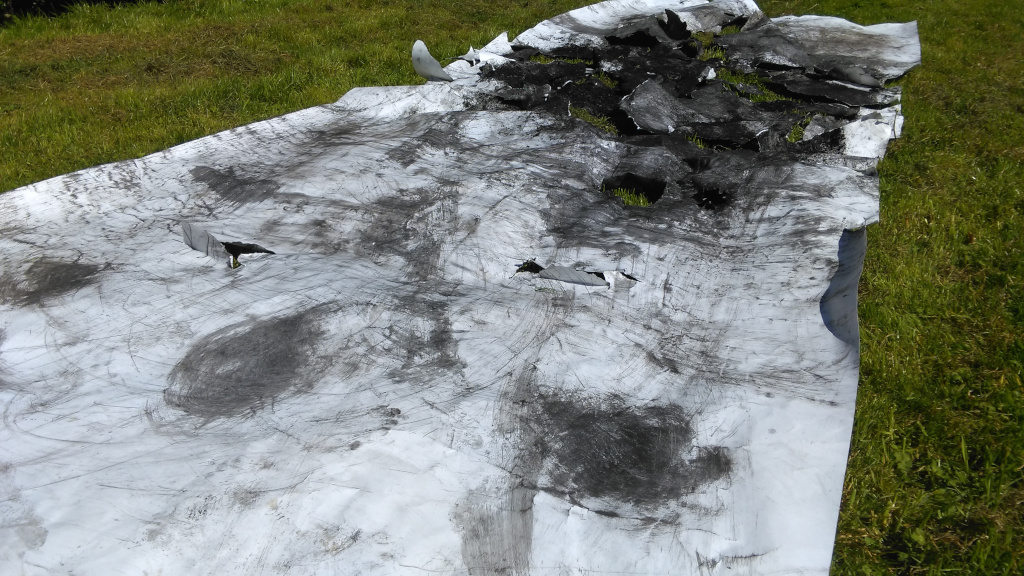On 20 April, the third residuals performance was held outside in the gardens of Dartington Hall, Devon. The four artists including me, had worked together on the second residuals performance but the exterior setting for the third performance brought it into the landscape and closer to nature.
Before

The other artists beside myself – Thom, Steph and John were very familiar with Dartington as they’d all studied at Schumacher College – part of the Dartington Estate in Devon. The decision to situated the third performance outside was not difficult – we simply left Thom’s Dartington Studio and walked the grounds finding a place in which we all felt comfortable. Thom’s brother Shaun, accompanied us with his film and stills cameras to record the event.
As before, paper was set down on the ground. Tools and other artefacts were laid beside the paper. A bag of charcoal granules (bio-char) was there too.
Setting the drawing paper out on the grass, the bright sunlight cast shadows from the tree near where we were to perform. The beautiful shadows which varied as the sunlight came and went, were an artwork in itself. Was anything more than the dance of light and shadow needed?

Performance
Prior to the performance, we agreed a simple score including drawing the granules with our bodies. A drawing!
We also introduce a rake with the intention of creating patterns in the charcoal granules. One of the inspirations for this, was the Zen Garden (‘dry garden’) at Dartington. Here the gardeners use wooden rakes with widely spaced teeth to create spirals and other patterns in gravel. We used a rather bent metal rake which while it moved the charcoal, it didn’t create geometric patterns! There was insufficient charcoal granules. Still, the gardening element of the performance was evident especially as we introduced water on the paper surface with two watering cans. The softened paper tearing, allowing the pieces to be draped over the stonework and arches nearby.
It was difficult for me to appreciate the whole performance as I simply couldn’t see the whole – I was a performer in it. There was a stationary video camera recording beside the paper but some of performance was off camera, and off the paper. Now that we were outside and not contained by the walls of the studio then the performers wandered, hid and used the outdoor setting in the improvised performance.
If you view the video above, and you speed it up at the start by dragging the slider across then you can see that the tree shadows move across the paper surface. Indeed, at the end of the film then the compression of the grass by feet trampling it, can also be seen.
Steph in her performance, introduced a tree branch which she planted through the paper surface into the ground below. She also introduced other new performance elements, getting under the paper so it was like a blanket over her. Of course, we continued to draw the charcoal over her body although the mark-making didn’t particularly reveal the form.
After


The drawing paper was fragmented but we reassembled it – as best we could – into it’s original rectangular shape. The surface of the paper was even more like a landscape than the previous performances as the paper had flexed more, and its torn centre from one edge of the paper to the other, was like a river valley. The blackness of the charcoal around the tear suggested burning, scarring or some trauma.

The grass beneath the paper was evident: it lifted the finished drawing giving it volume – almost levitating it. Perhaps the grass should be an integral part of its display in future? It certainly adds colour to an otherwise monochrome drawing.
At the end of the performance, we swept the charcoal into the flower bed and onto the soil. Charcoal can also be used as a soil enhancer when it is known as bio-char.
Hindsight
In this performance, the three other artists brought more of their practice into the performance. Being outside in the open air influenced it too. The beautiful tree shadow and the grass, is not something that is usually found in an artists studio.
The exterior setting was perhaps the most significant development in the residuals performance series. Now it is was part of the natural landscape.
